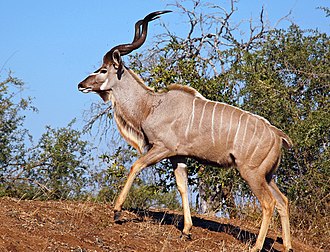
The greater kudu is a large antelope species which is found in southern and eastern Africa. While they are found across a large area, due to deforestation, poaching and humans taking their habitat for other uses, it is increasingly fragmented, and live in sparsely population groups throughout its range. Oddly, its closest relations are the Elands, and is there are a few species which are more closely related to the greater Kudu than the lesser Kudu.
This clearly makes it more susceptible to local extinction, as it would not take much increased hunting.
The horn is quite notable, and as such it is hard to mistake males for any other antelope. The horns grow at a rate of roughly 3 years per spiral, and is fully grown when it is 2 and a half spirals long, (so a male is fully grown at 7.5 years)
Below is a list of the currently recognized subspecies.
- T. s. strepsiceros – southern parts of the range from southern Kenya to Namibia, Botswana, and South Africa
- T. s. chora – northeastern Africa from northern Kenya through Ethiopia to eastern Sudan, Somalia, and Eritrea
- T. s. cottoni – Chad and western Sudan
They are thought to have a wild population of around 118,000 individuals, which means that they are pretty safe as a whole.
[smart_post_show id=”15038″]











